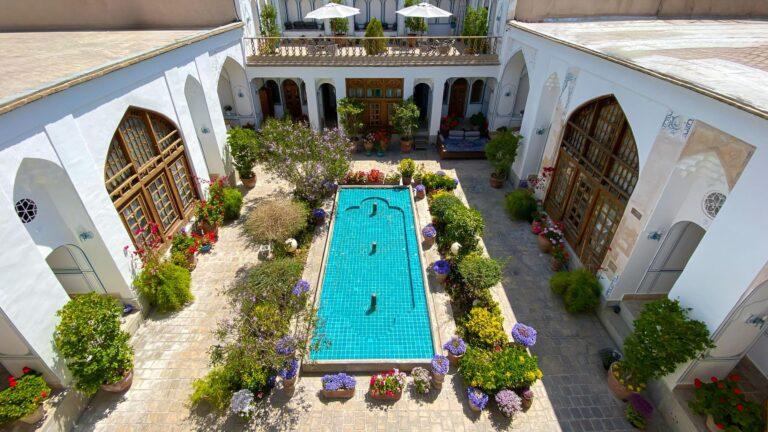
Samaian Mansion
The Samaian Mansion, now known as the Isfahan Traditional Hotel, is a profound and enigmatic structure that was erected over 450 years ago in the heart of the historic fabric of Isfahan. This mansion stands in the ancient neighborhood of Jorjir, where history is eternally engraved in the wrinkles of the walls and the intricate patterns of arches, with every brick bearing witness to the ups and downs of centuries gone by.
The Jorjir neighborhood dates back to the glorious Al-Buyeh dynasty in the 4th century AH (Islamic calendar). While the portal of the Jorjir Mosque belongs to the Deylami era, the market itself was constructed during a time when Isfahan flourished as a key center of governance, culture, and science, experiencing one of the brightest periods in its history. With the support and patronage of the Buyeh rulers, Isfahan became a hub for the development of Islamic knowledge and arts, and many valuable artifacts from that era can still be found scattered across the city’s alleys and corners.
The historic portal of Jorjir, which today stands as one of the most prominent architectural relics of that time, serves as a gateway to the distant past, reminding visitors of the grandeur and splendor of those eras. In its heyday, this market was the heartbeat of trade and culture in Isfahan. Despite the twists and turns of history, it has managed to preserve its vitality, now serving as a place where art, history, and contemporary life intersect harmoniously.
Today, with the transformation of the Samaian Mansion into the Isfahan Traditional Hotel, this building not only serves as a residence for travelers, but also acts as a bridge between the past and the present. The walls of this mansion, with open arms, whisper tales of the lives of past inhabitants, the magic of ancient times, and the rich culture of Isfahan into the ears of its guests. Every corner of this hotel offers not just a pleasant stay, but also a journey into the depths of history—an authentic Iranian experience that still echoes in the footsteps of those who walk through it today.
Inner and Outer Courtyards: A Sanctuary for Life and Hospitality
The Samaian Mansion is composed of two distinct sections: the inner courtyard (Andaruni) and the outer courtyard (Biruni). These two spaces, like two sides of the same coin, reflect the thoughtful division between private and social spheres in the traditional lifestyle of Iranians. Each courtyard played a unique role in maintaining order and protecting the privacy of the household.
Inner Courtyard (Andaruni): A Private Sanctuary
The inner courtyard was primarily reserved for the family members, offering a private space for their daily lives. Its most prominent features include:
- Private Use: Dedicated to family members, especially women, and those closest to the family.
- Privacy Protection: High walls and lattice windows ensured the privacy of the residents by blocking views from outside.
- Greenery and Pool: Trees and flowers, along with a water pool at the center, provided a sense of tranquility and helped cool the courtyard during the summer months.
- Seasonal Rooms and Verandas: Summer rooms faced north to remain cool, while winter rooms faced south to maximize sunlight and warmth throughout the year.
- Restricted Access: The inner courtyard was not directly accessible from the entrance and required passing through narrow passageways or corridors with lowered ceilings, preserving the household’s privacy.
Outer Courtyard (Biruni): A Space for Social Interaction
In contrast, the outer courtyard was designed for hosting guests and facilitating formal activities. Its key features include:
- Formal and Social Space: A venue for meeting guests, hosting ceremonies, and conducting official business gatherings.
- Grand and Ornate Verandas: This space was decorated with more elaborate architectural elements, highlighting the prestige of the household.
- Separation from the Inner Courtyard: To maintain privacy, the outer courtyard was kept separate from the inner sections of the house.
- Trees and Fountains: These elements added beauty while also contributing to a refreshing and cool atmosphere.
- Independent Entrances: Larger residences often had separate entrances from alleys or streets leading directly to the outer courtyard.
Today, both courtyards have preserved their historical essence, standing as a testament to the architectural brilliance of the past. The outer courtyard has been transformed into the café-restaurant of the complex, offering guests a chance to experience the charm of traditional hospitality. Meanwhile, the courtyard you are currently standing in is, in fact, the inner courtyard (Andaruni) of this historic mansion.
A Step into History
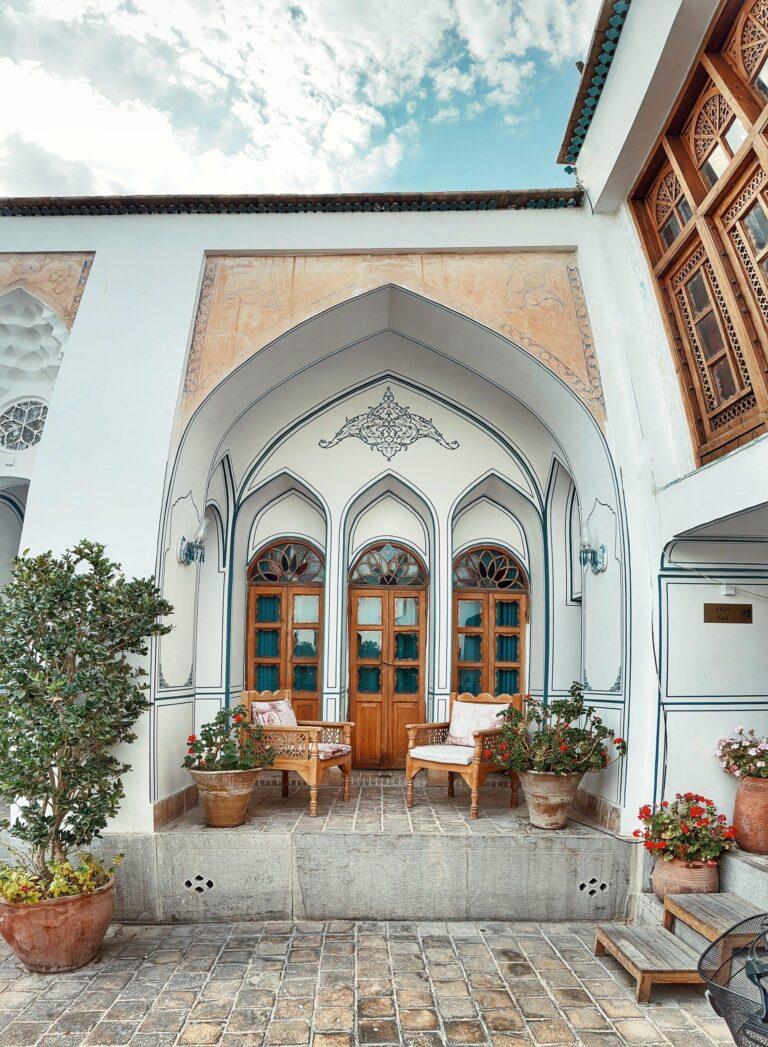
Today, Isfahan Traditional Hotel is not just a place to stay but a living museum of Iranian architecture and culture. Every corner of the building, from the plasterwork of the Safavi era to the colorful motifs of the Qajar period, tells a story from the past.
As you step out of the hotel lobby and enter the courtyard, a closer look at the engraved wall decorations on the right reveals the patina of time and the age-old beauty of history settled on them. These engravings serve as an identity card that reflects the hotel’s 450-year-old legacy.
During the first restoration of the building, samples from this section were sent for precise laboratory testing, officially confirming the authenticity and antiquity of this historic hotel
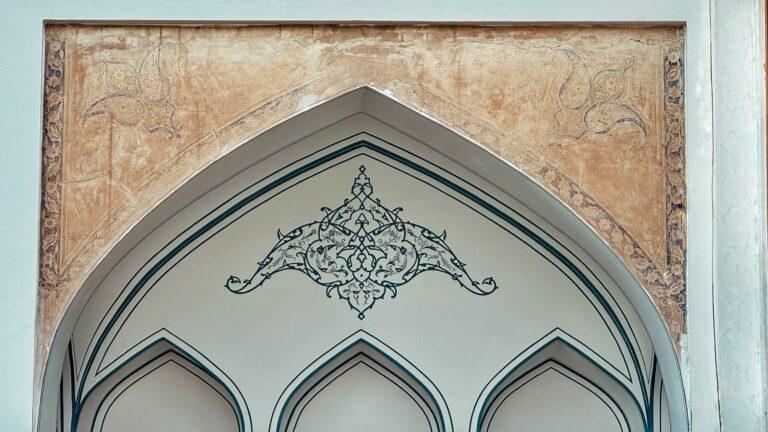
Reviving the Past’s Glory at the Heart of History
Since its establishment as the Traditional Hotel of Isfahan in 2007, this valuable mansion has undergone three major restoration phases. Throughout each phase, the preservation of the building’s authenticity and delicate details has been the foremost concern of the architects and restorers. Every repair and reconstruction has been carried out with meticulous care and respect for the structure’s historical identity, ensuring that the soul of the building remains alive and untouched.
A closer look at the walls and intricate patterns reveals a broad spectrum of designs and colors, each representing a distinct historical period. These decorations not only showcase the richness of Iranian art, but also unfold the mysteries and stories of centuries past, like the pages of an ancient book, telling the tales of bygone eras.
- The first phase of restoration, initiated before the hotel’s opening, focused primarily on repairing deteriorated sections and stabilizing the core structure to ensure its integrity.
- The second phase, completed in 2021, delved deeper into the mansion’s hidden historical elements, which were unearthed through meticulous exploration and carefully documented. This phase placed special emphasis on restoring the original elegance of the wall decorations and columns to revive the charm and craftsmanship of the past.
- The third and most recent phase has just concluded, with a focus on structural sustainability and maintaining the building’s aesthetic and functional integrity for future generations. During this phase, the restorers achieved a harmonious balance between preserving the ancient identity of the mansion and adapting it to meet modern needs, creating a space that is both charming and authentic for today’s visitors.
This careful and thoughtful restoration journey has transformed Isfahan Traditional Hotel into a space where the past meets the present. It offers not just a place to stay, but an immersive experience of history, inviting guests to step into the heart of Iran’s architectural legacy, where beauty, authenticity, and modern comfort coexist in perfect harmony.
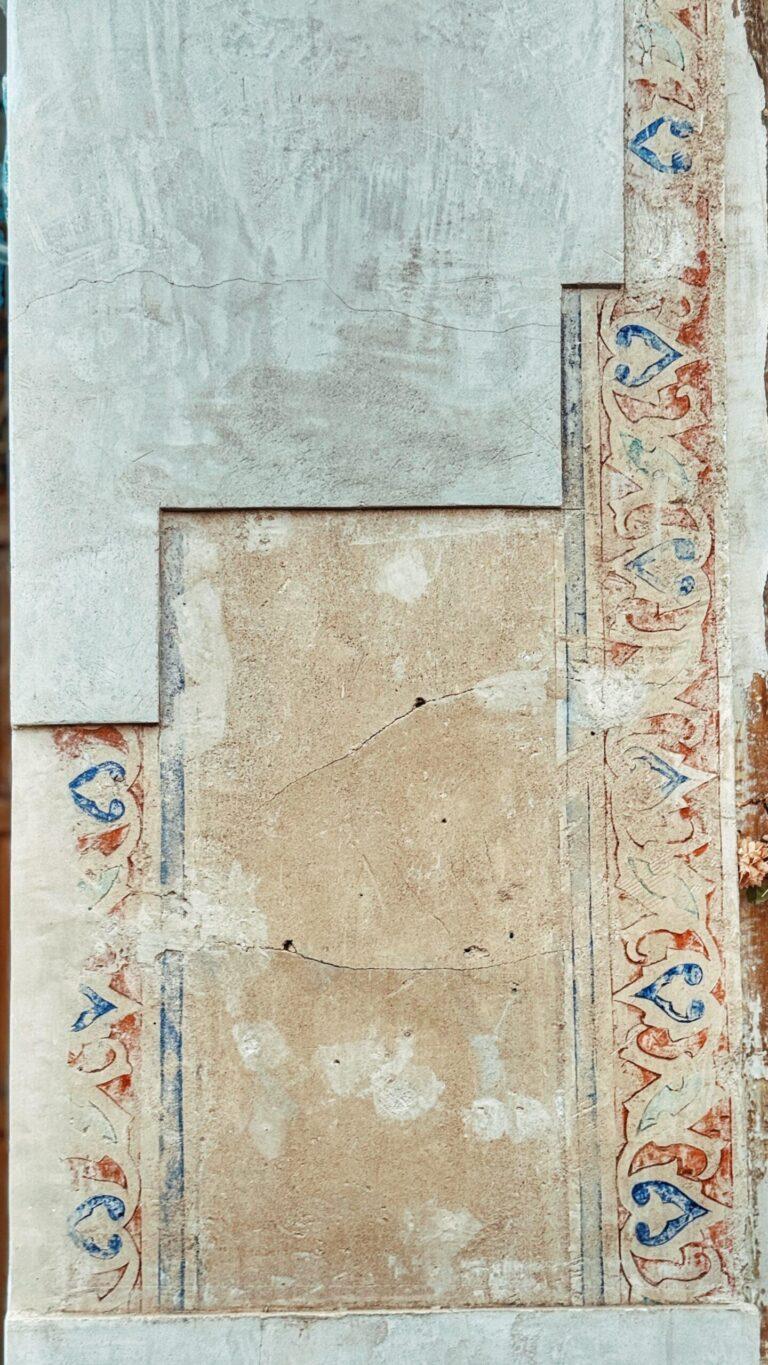
The Reflection of History in Colors
Detailed and meticulous analysis revealed that the paintings and decorative motifs in the image date back to the turbulent Qajar era. These ornaments, crafted with artistic precision and elegance, vividly reflect the architectural style of that period. Among the employed designs, the dominant colors of red and blue stand out with captivating brilliance.
In Qajar architecture, the color red has always symbolized passion and vitality, serving as a representation of movement and energy in decorations. Alongside it, blue, in its various shades, conveyed tranquility, power, and spirituality, holding a special place in the art of the era. Together, these two colors create a beautiful balance between joy and dignity, dynamism and stillness, imparting a majestic splendor to the architecture of the time.
These color schemes function as a hidden language, expressing the beliefs and values of the Qajar period. In architectural structures, they establish a harmony between materiality and spirituality, reflecting the essence of the time.
The surviving decorations from that era confirm that art was not merely decorative but served as a medium for expressing identity and societal beliefs. Every glance at these motifs offers a journey into the thoughts and visual aesthetics of the Qajar era, where art and culture intertwined to present a tangible narrative of Iran’s history.
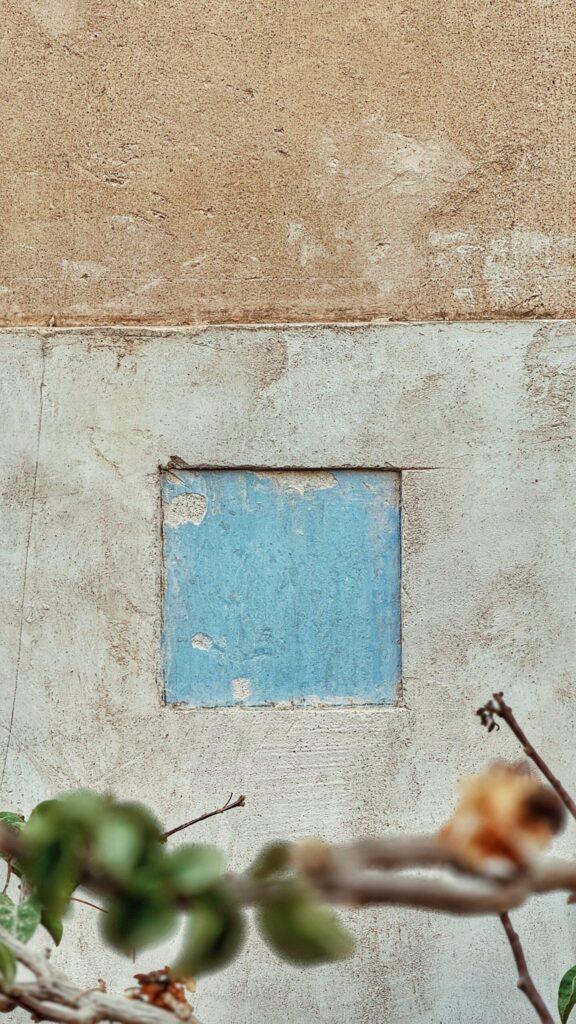
With a bit of careful observation and a keen eye, you’ll notice a patch of light blue on one of the columns. This small detail is a remnant from the Pahlavi era—a period when light blues and grays were widely used in architecture and art. These colors reflected the new cultural and artistic inclinations of the time, moving toward minimalism, simplicity, and an aversion to elaborate ornamentation.
The use of soft, neutral colors like light blue and gray signaled a shift in artistic taste, favoring calmness, balance, and moderation in design. This new approach stood in stark contrast to the vibrant and decorative aesthetic of the Qajar period, where bold hues dominated. In Pahlavi architecture, simplicity and practicality replaced the intricate embellishments and ornate details of earlier eras—a transformation visible not only in architecture but also in the lifestyle and visual landscapes of the time.
This contrast between the lively colors of the Qajar era and the visual serenity of the Pahlavi period offers visitors a unique opportunity to witness and experience the cultural, artistic, and social transformations that shaped Iranian architecture. The columns and walls of this mansion serve as mirrors reflecting the layers of history, with each layer capturing the spirit of its time and preserving it within the structure.
A Testament to History
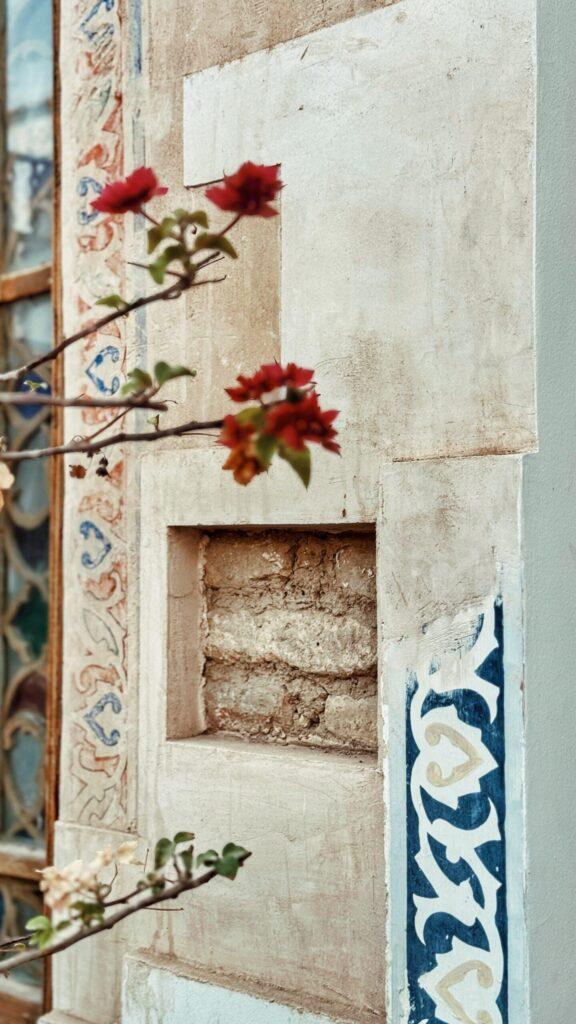
During the restoration efforts, ancient bricks were uncovered from within the walls. These bricks date back to the Safavid era and reveal the original structure of the building. Their discovery confirmed the historical value of the mansion, as the use of simple yet durable materials was common in Safavid architecture, making these bricks a hallmark of the building’s authenticity.
Archaeologists, after sampling and testing the bricks in specialized laboratories, identified them as key evidence of the hotel’s 450-year-old heritage. This discovery not only validated the importance of the structure but also unveiled the foundation and essence of traditional Iranian architecture.
Architecture in Harmony with History and Modernity: Pillars of Timeless Identity
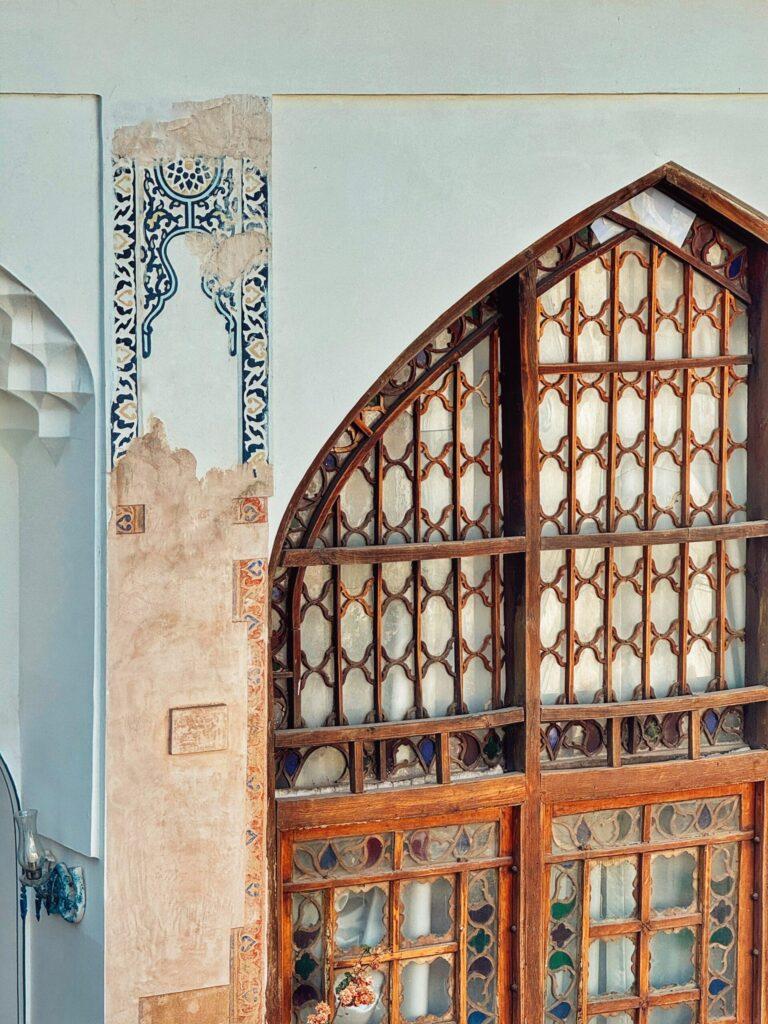
In the upper sections of the columns, exquisite decorations featuring a harmonious blend of navy blue and cream hues catch the eye. These designs are the result of the first phase of the building’s restoration, completed in 2007. Crafted with remarkable precision and meticulous care, these embellishments were executed to ensure that the essence and soul of the structure remained intact. As mentioned earlier, great effort was made to preserve even the smallest details, ensuring that no compromise was made to the historical identity of the building.
The patterns and motifs displayed in these decorations reflect the architectural precision of the Qajar era, capturing the spirit of that time. The only significant difference lies in the slight variation in color palettes, carefully chosen to align with the principles of modern restoration while maintaining harmony with the original design. These subtle changes allow the building to resonate with contemporary aesthetics without diminishing its authenticity and historical value.
This delicate interplay between loyalty to the past and alignment with the present serves as a testament to the skill and artistry of the restorers, who have succeeded in breathing new life into the historic fabric of the mansion. The result is a structure where the splendor of bygone eras seamlessly merges with modern sensibilities, ensuring that the identity of the building remains vibrant and relevant, preserving the spirit of the past while welcoming the future.
The Love and Affection Talisman: A Hidden Secret Within the Walls
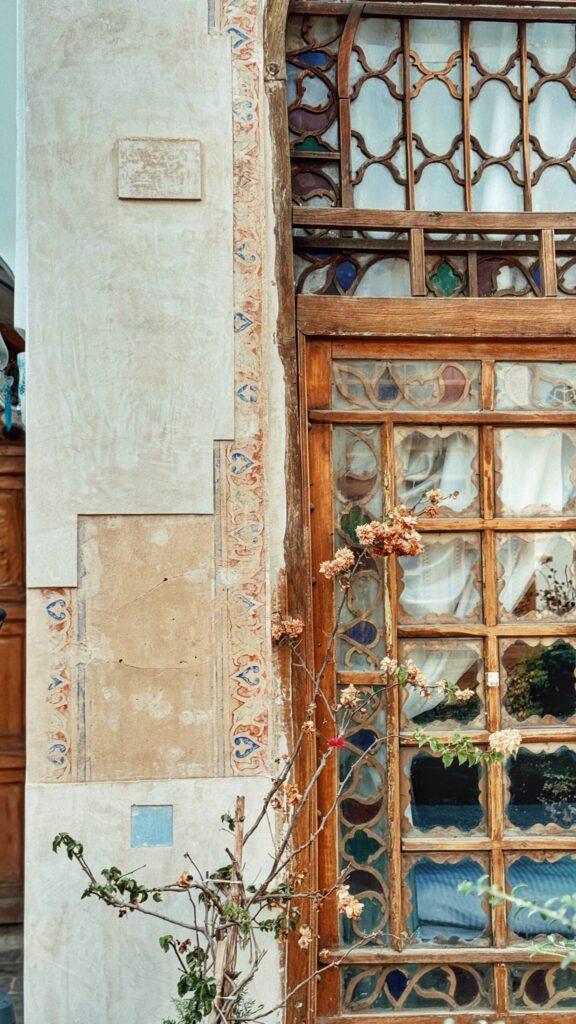
With a closer look at the lower sections of the wall, a protruding frame emerges, as if it is revealing hidden secrets from the depths of history. During the second phase of restoration in 2021, an ancient talisman was uncovered from within the wall. This talisman contained remarkable elements, including bird feathers, a piece of leather, and bird bones.
Through detailed archaeological studies, it was identified as a Love and Affection Talisman, with a complex and enigmatic purpose—designed to prevent the formation of emotional bonds for the residents of the mansion.
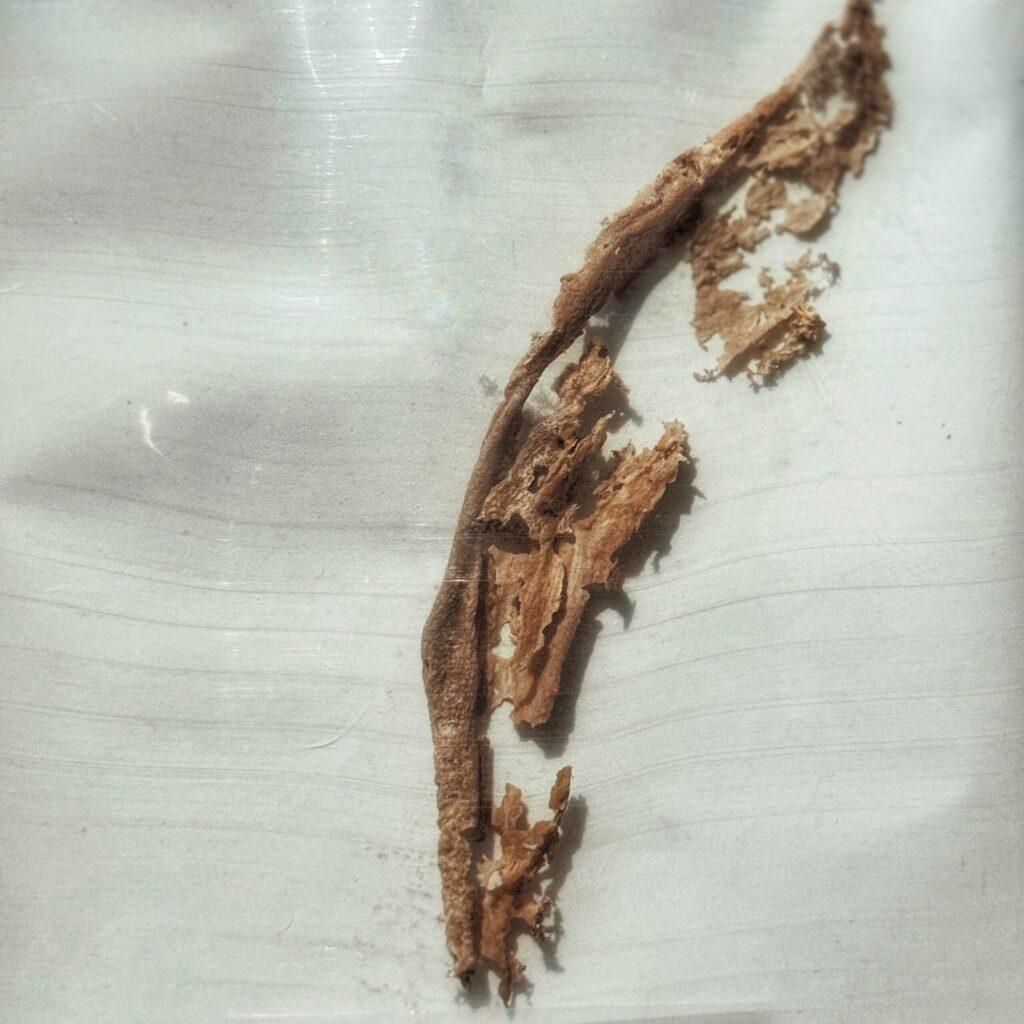
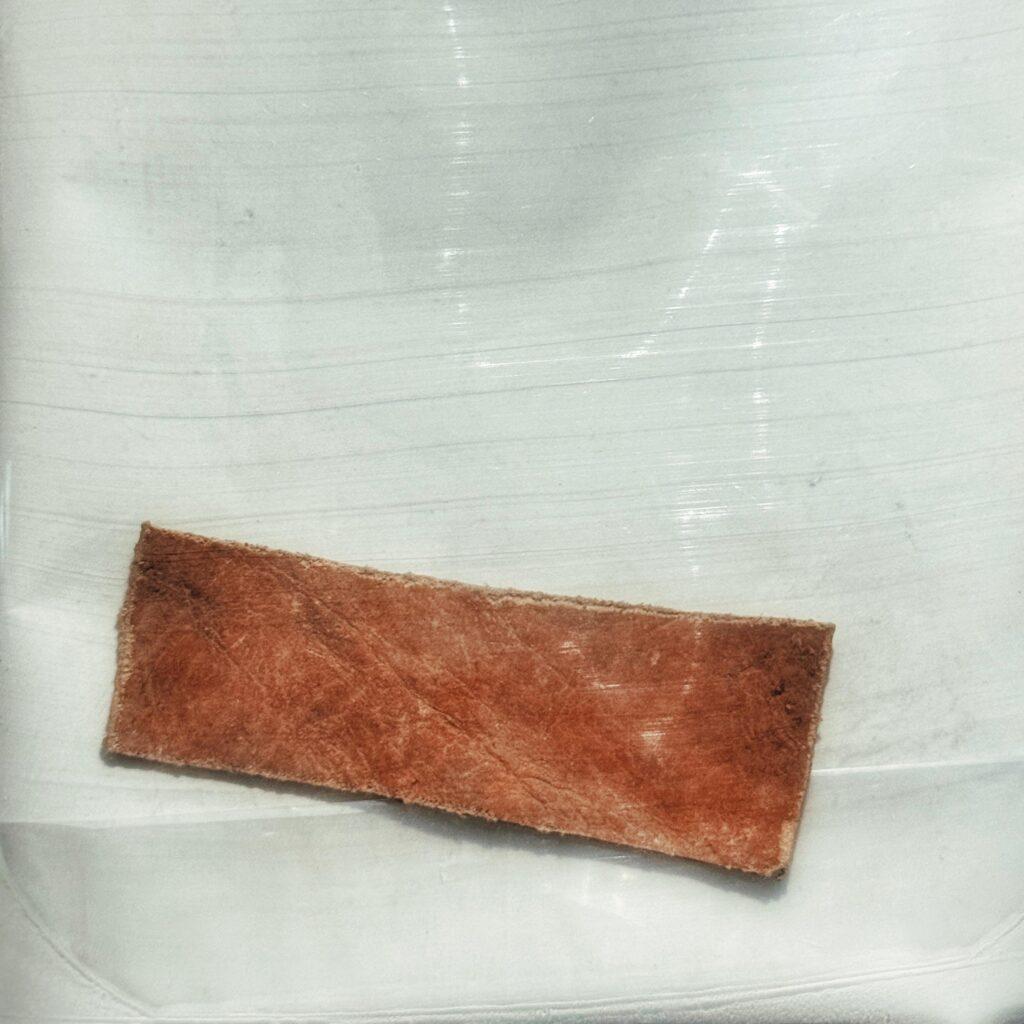
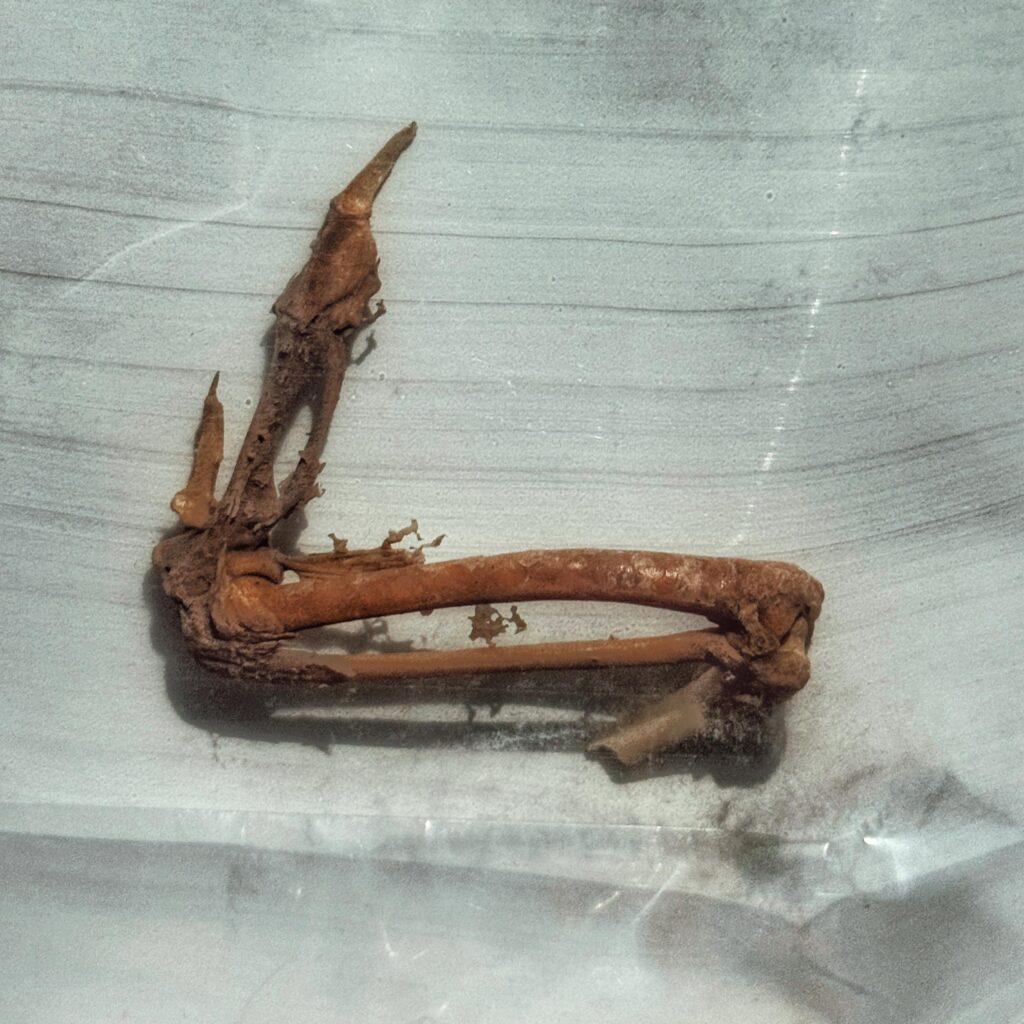
The most renowned residents of this house in history were the nieces of Rahim Arbab. Rahim Arbab was one of the greatest Shi’a scholars, mystics, and philosophers and a prominent and distinguished figure in Isfahan. He was known for his simple way of life, adherence to moral and religious principles, and aversion to luxury and extravagance. His name remains honored in Isfahan as a symbol of knowledge, ethics, and mysticism, and in recognition of his legacy, one of the city’s major streets has been named “Rahim Arbab.”
Reliable accounts narrate that his two nieces, both young women, were residents of this house. They lived alone in the mansion for the rest of their lives and never married. It is possible that their solitary lives were influenced by the talisman hidden within the walls, which may have blocked emotional relationships from forming.
Thus, this mansion stands as the scene of a silent tragedy, a narrative woven from tradition, hidden secrets, and unwritten destinies, holding within its walls the untold stories of those whose lives were shaped by forces both seen and unseen.
